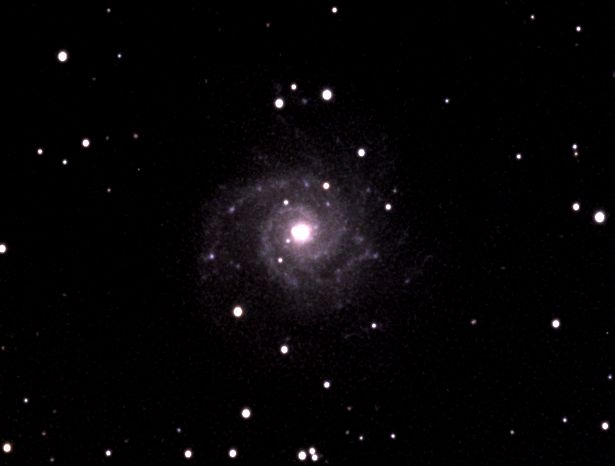
M74 is a beautiful spiral galaxy of magnitude 10.0 located a couple of degrees northwest of the star Eta Piscium. M74 is one of the best examples of a face-on Sc-type spiral galaxy. It is a faint and elusive object for amateur size telescopes, and requires a dark clear sky in order to be seen in most amateur telescopes. Amateur astronomers doing a Messier marathon often miss this galaxy in the evening. During a marathon, this galaxy must be observed low in a twilight sky before it sets. This galaxy, along with globular cluster M30, are typically regarded as the most difficult objects to log in a Messier marathon.
The galaxy was discovered by P. Mechain in September 1780. It was one of the first "Spiral Nebulae" that were recognized. The galaxy is located about 30 million light years away. At that distance, the galaxy would measure about 80,000 light years across. The spiral arms of the galaxy contain clusters of blue young stars and several pinkish-red H II regions of gaseous nebulae, providing evidence of active star formation occurring in M74.
Japanese amateur astronomer Yoji Hirose discovered supernova 2002ap in M74 on January 29, 2002. At that time, the supernova was only magnitude 13.7. You can see what a supernova looks like when it explodes in a distant galaxy by looking at my image of a supernova in M51.
This is a composite RGB CCD image taken from my backyard in Scottsdale, Arizona. The RGB data was taken on January 1. The luminance data was taken the next night. The images were taken with an SBIG ST-8E CCD at prime focus on a Takahashi FCT-150 refractor at f7. The telescope was carried on a Takahashi NJP Temma mount.
M74 (NGC 628)
Constellation: Pisces
RA: 01h 36m 51.0s Dec: +15d 47' 55"
January 1, 2003
Image by Sid Leach
Scottsdale, Arizona
Recent Images.
Complete list of images.
Description of equipment used to acquire images.
Home
Feedback and comments should go to Sid